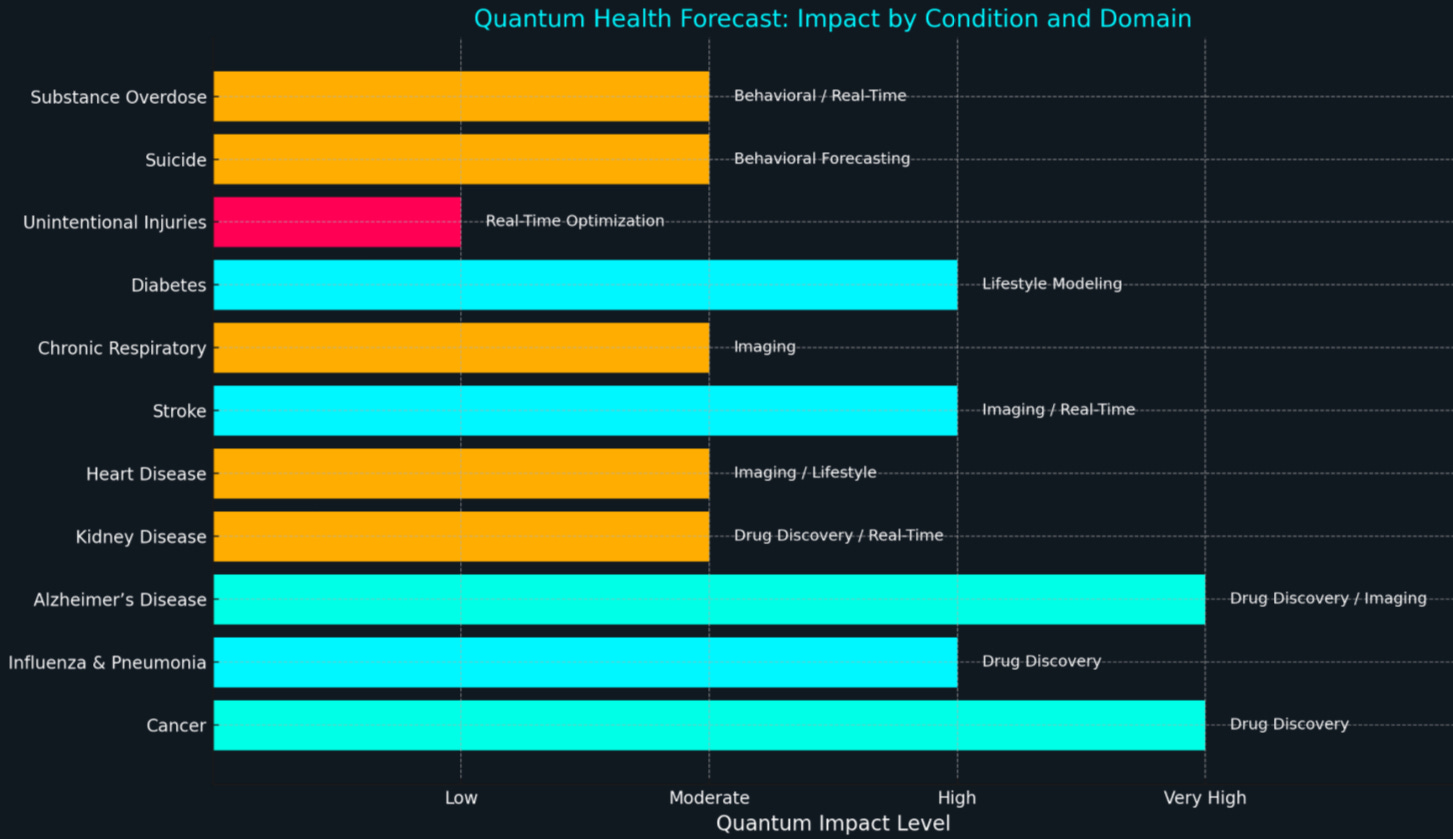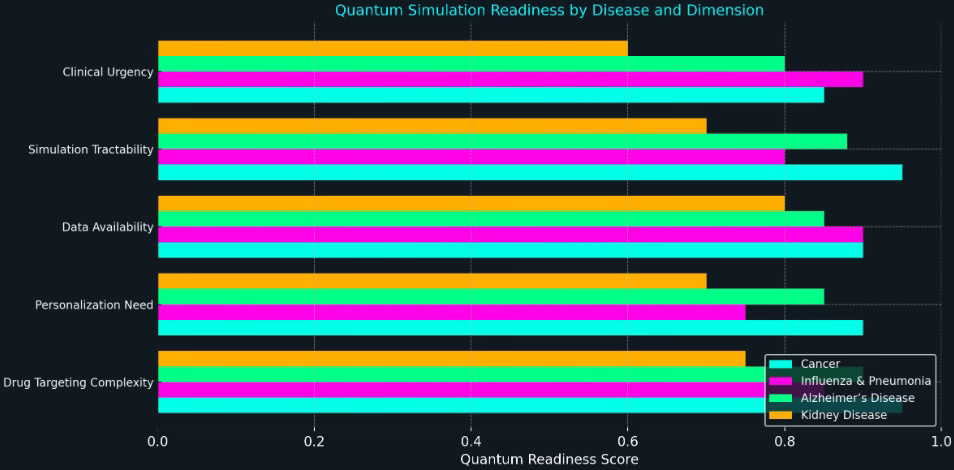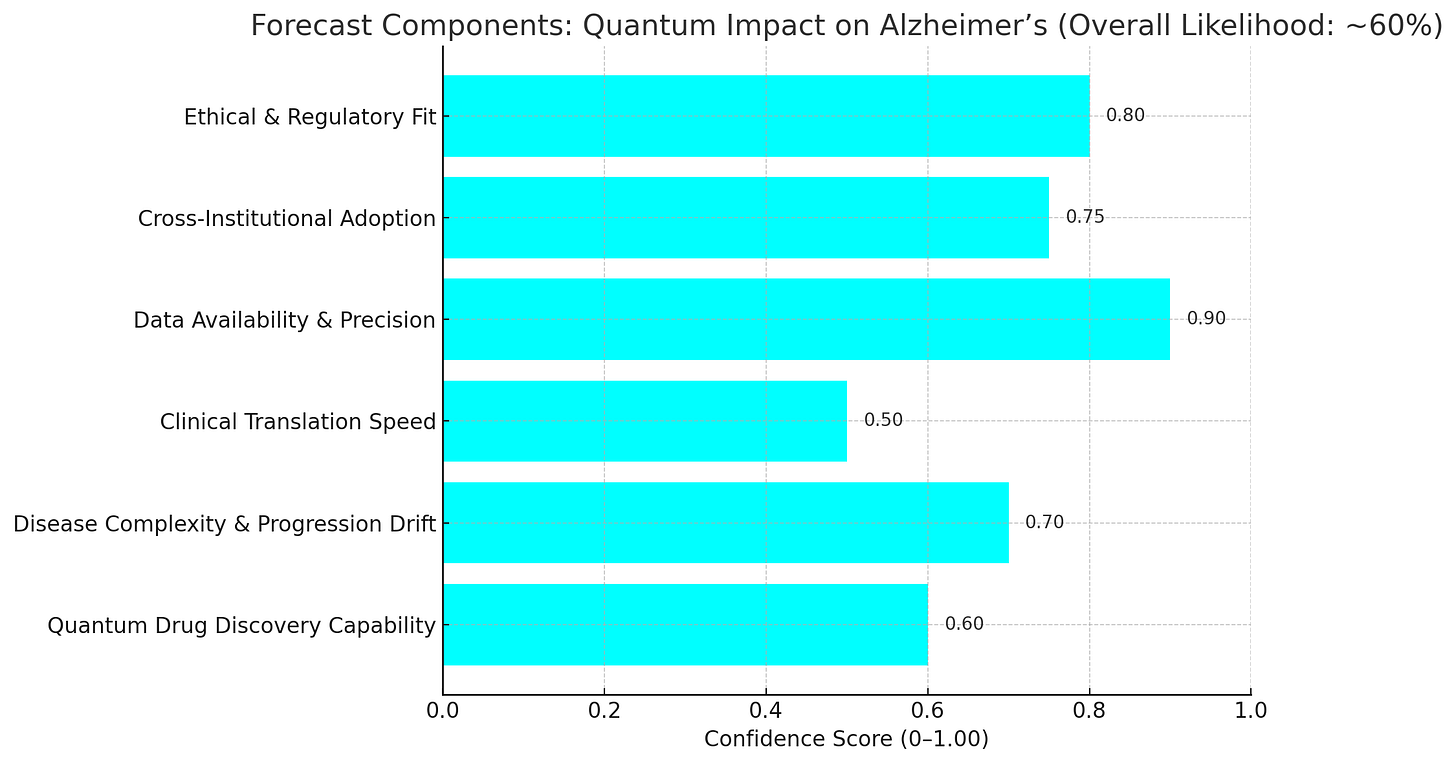MCAI Health Vision: Alzheimer’s and Quantum Computing Forecast
Comparative evaluation of quantum simulation readiness across neurodegenerative domains based on five critical performance indicators
Companion study to MindCast AI Health Vision: Cancer and Quantum Computing Forecast, Comparative evaluation of quantum simulation readiness across core therapeutic domains based on five critical performance indicators (April 25, 2025)
Executive Summary
MindCast AI LLC (MCAI) presents this white paper in response to quantum computing’s rising role in decoding chronic and progressive diseases, particularly neurodegenerative disorders like Alzheimer’s. While cancer has dominated early stage quantum healthcare narratives, Alzheimer's offers a distinct opportunity: long-horizon simulation of subtle biological decay, cognitive erosion, and emotional disruption. These traits make Alzheimer’s a compelling target for modeling disease progression with quantum precision.
Quantum Health Vision is MCAI’s framework for forecasting quantum impact across therapeutic categories. By integrating quantum systems with Cognitive Digital Twins (CDTs), we simulate the interplay of patients, treatments, and biological engines—recasting Alzheimer's care as a dynamic, foresight-driven loop of cognition, behavior, and biology.
I. Overview: Drug Discovery & Progression Simulation
Alzheimer’s drug discovery has historically been marked by costly failures, uncertain biomarkers, and limited treatment success. Its molecular complexity—centered around amyloid plaques, tau tangles, and neural inflammation—poses unique challenges for classical simulation. However, quantum systems are now capable of modeling protein folding dynamics and long-range molecular entanglements at unprecedented resolution. This positions Alzheimer’s as a leading candidate for quantum-assisted simulation in both early detection and therapeutic design.
Unlike cancer, which benefits from rapid-response modeling, Alzheimer’s depends on high-fidelity, longitudinal simulation. The domain prioritizes progression mapping over intervention cycles, making it a natural fit for time-sensitive quantum models.
Insight: Alzheimer’s presents the clearest case for slow-cycle, high-fidelity quantum simulation—where breakthroughs hinge not on speed, but on deep memory of evolving biological pathways.
II. Simulation Framework: Triadic Model of Cognitive Care
To model healthcare for Alzheimer’s patients, MCAI uses a triadic loop that mirrors real-world care complexity. Patients, treatments, and the quantum engine are each represented as adaptive agents, entangled in ongoing recalibration based on biomarkers, cognition, and emotion. This design allows healthcare models to evolve as the disease progresses—accommodating changes in memory, behavior, and social response over years rather than days.
The Patient CDT integrates cognitive tests, family interactions, and emotional cues. The Treatment CDT accounts for tolerance, adherence, and cognition-specific efficacy. The Quantum Simulation Engine models the molecular terrain where interventions unfold.
CDT Simulation Focus Areas (Alzheimer’s Context):
Patient CDT captures cognitive decline patterns, behavioral variance, genetic predispositions (e.g., APOE4), sleep and stress biomarkers, and social interaction shifts.
Treatment CDT models drug efficacy over time, side effect tolerance, adherence profiles, and cognition-interaction feedback (e.g., memory-loop effects).
Quantum Simulation Engine focuses on protein misfolding (amyloid-beta, tau), neuroinflammation cascades, and long-range synaptic modeling to predict disease trajectory under treatment stress.
Insight: Alzheimer’s care benefits from a simulation model that treats memory loss not as a static event, but as an evolving system—requiring continuous cognitive feedback across all simulation layers.
III. Deep Dive: Quantum Computing & Alzheimer’s
Alzheimer’s remains one of the most complex diseases in neurology, affecting over 6 million people in the U.S. alone. Its progression is gradual, often beginning years before symptoms emerge, and unfolding through molecular signatures that elude classical detection systems. Quantum computing offers a new lens for simulating the misfolding of amyloid-beta and tau proteins, forecasting cognitive decline trajectories, and identifying moments where intervention could shift long-term outcomes.
Traditional models are constrained by slow data throughput and limited pattern recognition across years of decline. Quantum simulation changes that—allowing billions of molecular interactions to be tested in parallel and linked with cognitive pattern forecasts through the CDT framework.
Insight: Alzheimer’s is less a disease of crisis and more a disease of accumulation—making it a uniquely powerful use case for quantum computing’s strength in high-dimensional, time-based modeling.
IV. Strategic Levers to Accelerate Progress
Unlocking quantum’s full potential in Alzheimer’s care requires more than hardware breakthroughs. It demands alignment across multiple fronts: regulation, biological standards, trust systems, and simulation frameworks. Alzheimer’s-specific modeling must integrate cognitive data, genetic risk, emotional state, and molecular decay into a unified simulation environment.
Strategic levers include improved interface standards for protein folding, robust AI-quantum hybrid tools to prioritize long-horizon compounds, and CDT-led modeling of cognition-sensitive interventions. Narrative infrastructure must also evolve to communicate probabilistic forecasts to families and clinicians.
Insight: The power of quantum in Alzheimer’s care lies not just in simulation speed, but in ecosystem coordination—connecting data fidelity with emotional trust and clinical usability.
V. Aging, Care Systems & Memory-Based Forecasting
Alzheimer’s simulation isn’t only about the patient—it’s about the entire care network. Families, institutions, and long-term caregivers operate under intense emotional and logistical strain. By simulating decline trajectories, behavior patterns, and medication responsiveness, quantum-CDT systems can support everything from home planning to institutional readiness.
This approach allows for dynamic forecasting of caregiver burden, long-term costs, and intervention success rates—turning aging into a domain of anticipatory logic rather than reactive strategy. With patient CDTs calibrated for emotional variance and behavioral trends, MCAI enables scenario modeling at both individual and system levels.
Insight: Alzheimer’s simulation is a model for memory-informed policy—where care isn’t delayed until symptoms emerge, but forecasted years in advance using quantum cognition engines.
VI. Forecast Outlook: Quantum-Driven Alzheimer’s Breakthroughs
Using the MCAI Forecast Flow system—which integrates Bayesian updating, foreseeability filters, and system-level probability mapping—we estimate the likelihood of a quantum computing–enabled therapeutic breakthrough in Alzheimer’s within the next two decades.
By 2030: ~15% likelihood of a quantum-assisted discovery reaching Phase III trials.
By 2035: ~35% likelihood of a quantum-modeled therapeutic achieving FDA approval or equivalent regulatory validation.
By 2040: ~60% likelihood of a transformative treatment or simulation-driven protocol measurably slowing disease onset or progression in early-stage patients.
These forecasts assume continued funding, hardware scale-up, and the successful integration of quantum models into biological and regulatory workflows.
Insight: Alzheimer’s is unlikely to yield to a singular quantum cure, but the forecasted trajectory strongly favors quantum systems catalyzing a new era of preventative and progression-slowing interventions over the next 10–15 years.
VII. Simulation Readiness Scorecard
Below is MCAI’s simulation readiness assessment for Alzheimer’s, scored across five core quantum health dimensions (0–10 scale):
DimensionScore (0–10)NotesMolecular Complexity Fit8High protein folding relevance (amyloid-beta, tau).Long-Term Data Availability9Rich datasets from longitudinal studies and aging cohorts.Clinical Urgency6High public burden, but slow onset lowers triage priority.Simulation Tractability7High for progression models, moderate for intervention simulation.Personalization Potential9Strong fit for CDT and genetic-based risk modeling.
Insight: Alzheimer’s scores very high on personalization and long-term simulation value, even if near-term clinical disruption is lower than in cancer or rare disease cases.
VIII. Visual Forecast Timeline
Alzheimer’s quantum impact forecast: simulation maturity and breakthrough probability (2025–2040).
| Year | Milestone | Estimated Probability |
|------|-----------------------------------------------|------------------------|
| 2027 | Prototype CDT + quantum hybrid for misfolding | 25% |
| 2030 | Phase III-ready quantum-modeled compound | 15% |
| 2035 | FDA approval of quantum-assisted therapy | 35% |
| 2040 | Widely adopted quantum-enabled care protocols | 60% |Insight: Alzheimer’s simulations evolve linearly but compound meaningfully, with breakthrough points emerging in 2030–2040 from slow accrual of molecular, emotional, and behavioral fidelity.
IX. Simulation Archetype Classification
MCAI classifies quantum-CDT Alzheimer’s modeling under:
Pathway-based: Models interlinked progression of protein folding, cognitive loss, and neural decay.
Ecosystem-based: Simulates family-caregiver-institutional networks and emotional-cognitive burden.
Alzheimer’s is less aligned with target-based simulation due to fewer high-specificity molecular interventions currently validated.
Insight: Alzheimer’s simulation value increases when reframed not as a target model but as a behavioral-ecological loop spanning decades of degeneration and care.
X. Cross-Disease Quantum Fit Comparison
DiseaseQuantum FitSimulation ArchetypeNotesCancerVery HighTarget + PathwayMutation modeling, fast trial cycles.Alzheimer’sHighPathway + EcosystemLong memory arc, protein folding.Parkinson’sMediumPathwayLocalized degeneration, lower simulation use.ALSMediumTargetRapid progression, sparse data.CardiovascularLowEcosystemSimulation challenge due to high variance.
Insight: Alzheimer’s stands apart as the highest-yield neurological target for quantum-CDT modeling, especially when extended beyond drug design to life-path forecasting.
XI. Adaptive Crisis Planning & Late-Stage Simulation
Alzheimer’s care often enters periods of sudden strain—wandering episodes, hospitalization triggers, or caregiver collapse. These moments demand rapid decision-making across complex emotional and clinical environments. MCAI’s CDT simulation framework enables pre-emptive modeling of these late-stage risks by integrating patient signals, family behavior, and institutional response pathways.
Quantum-CDT models can forecast emergency scenarios with greater accuracy, simulate downstream effects of unplanned care transitions, and support real-time triage in long-term care settings. This allows families and healthcare systems to coordinate early and reduce catastrophic care gaps.
Insight: Alzheimer’s crisis planning is rarely clinical—it’s behavioral. Quantum-CDT simulations convert reactive breakdowns into proactive transition design.
XII. Policy & Public Signals: The Seattle Times Feature
A recent Seattle Times article highlighted Washington State’s momentum in Alzheimer’s research, caregiving strain, and emerging tech solutions. This growing public awareness aligns with national urgency and deepens the case for foresight-driven models that can predict and personalize future care.
MCAI’s Alzheimer’s platform can serve as a bridge—translating molecular discovery into caregiver-ready insight, and turning emerging research into emotionally calibrated protocols. The regional narrative is now ready for systems like MCAI that can scale clarity and trust.
Insight: When public momentum aligns with technological maturity, the missing layer is simulation foresight—MCAI supplies the connective tissue between scientific ambition and lived experience.
XIII. Interpretive Layer: Simulation Trust and Cognitive Calibration
Quantum systems alone cannot transform healthcare. What matters is how outputs are interpreted, trusted, and acted upon. MCAI’s CDT layer is built precisely for this—simulating not just biological events, but emotional cognition, moral friction, and behavioral forecasting. In Alzheimer’s, where fear, memory loss, and guilt shape every decision, this layer becomes essential.
CDTs allow stakeholders to rehearse decisions before they happen, understand how others will likely respond, and calibrate communication in advance. This adds stability, humanity, and reliability to a field too often governed by panic and uncertainty.
Insight: Alzheimer’s is a cognitive-emotional disease. MCAI’s interpretive simulation infrastructure makes quantum outputs trustworthy—not just accurate.
XIV. Implications & Next Steps
Quantum Health Vision reframes Alzheimer’s as a systems-level condition requiring computational memory, not just molecular insight. The combination of quantum mechanics, CDT simulation, and emotional foresight unlocks a new care architecture—one defined by adaptive modeling and cognitive durability.
For researchers and policy leaders, this opens a path toward predictive medicine in neurodegeneration. For technologists, it defines benchmarks for integrating simulation ethics, long-horizon data, and trust-centered user experiences. For families, it offers the hope of clarity—years before symptoms manifest.
Insight: Alzheimer’s quantum modeling isn’t about finding a moment of cure—it’s about shaping an ecosystem of early insight, trustable foresight, and memory-driven resilience.
Prepared by Noel Le, Founder | Architect of MindCast AI LLC. Noel holds a background in law and economics, behavioral economics and intellectual property.
LinkedIn: https://www.linkedin.com/in/noelleesq
mindcast.ai@icloud.com





